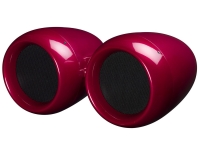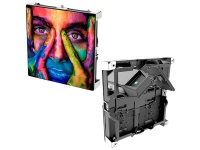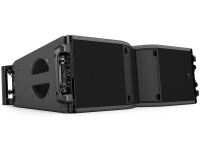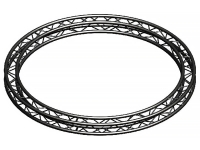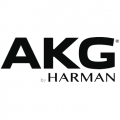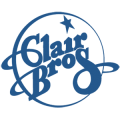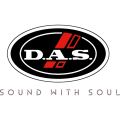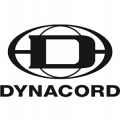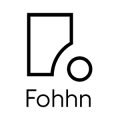ABOUT THE PRODUCT
ABOUT THE MANUFACTURER
GLOSSARY
Square ONE Splitter
The Square ONE Splitter is a user-friendly, high-performance, eight-channel, active microphone (mic) splitter designed for live sound reinforcement. Housed in a rugged and compact 2U rack enclosure, the Square ONE Splitter offers a cost-effective and space-effective method of providing up to 24 outputs from 8 sources. In addition, the Square ONE Splitter can also function as a 1 x 16 media splitter.
The Square ONE Splitter can distribute up to eight mic or line level signals to multiple locations, while maintaining signal integrity and minimising noise interference. Its primary application is to split the audio signals on-stage into individual feeds for front of house (FOH), monitoring (MON), multi-track recording, live broadcasting or indeed any other requirement; see Figure 1, Typical channel I/O connection options, on page 2. Although the Square ONE Splitter is a cost-effective unit, its signal integrity and audio performance mean it can be used with any console, and the quality of its preamp and circuitry can enhance the audio performance of lower cost consoles.
The Square ONE Splitter has eight channels, each consisting of two parallel inputs, two preamps, and a total of three balanced outputs. Two of the outputs (identical) are electronically balanced, while the other is transformer isolated. Both paralleled mic inputs feed two integral, superbly specified mic preamps, which are based on the circuitry used in the DL431 Mic Splitter (part of the acclaimed Midas XL8 Live Performance System). One preamp provides adjustable gain and drives the two electronically balanced outputs at increased levels (up to line level), while the second provides a fixed gain copy of the input and drives the transformer isolated output.
Channel controls consist of: solo, filter and phantom voltage pushbutton switches each with an adjacent LED for on/off indication; a gain control knob; and a dedicated peak reading meter for displaying the output at all times. The solo system allows any channel(s) to be monitored via the integral headphone amplifier. The gain control knob is used for optimising the preamp gain. Standard +48V phantom powering is individually switchable on each channel and has remote operation by virtue of its unique phantom voltage sensing feature.
Additional controls include a headphone level control (just above a headphone jack), a global ground lift switch per set of electronically balanced outputs and a media split switch. The media split switch activates media split mode, in which the output of channel 8 is distributed to all 16 electronically balanced outputs.
Features
The Square ONE Splitter has eight channels, each with:
- Two mic preamps, based on those used in the acclaimed Midas XL8 Live Performance System1; one drives the two electronically balanced outputs and the other drives the transformer isolated output.
- Two paralleled inputs, one front and one rear.
- Two electronically balanced outputs (rear panel), derived from the front control knob-adjusted mic preamp.
- One transformer isolated output (front panel), derived from a second fixed gain preamp.
Each channel is clearly labelled and includes the following controls:
- Rotary gain switch with nine positions. Range is from 0dB to +40dB in 5dB steps.
- +48V phantom power switch with adjacent LED for on/off indication.
- 30Hz high pass filter switch with adjacent LED for on/off indication.
- Solo switch with adjacent LED for on/off indication.
- Output meter with four LEDs, which indicate -15dB, 0dB, +12dB and +21dB.
Additional features include:
- Headphone output (1/4" jack) and level control to monitor the solo bus.
- Two global ground lift switches, one for each set of electronically balanced outputs.
- Media split switch for routing channel 8 to all 16 electronically balanced outputs.
- Phantom power sensing for remotely enabling +48V on the inputs when phantom power is activated from any attached console.
- Male (output) and female (input) XLRs with gold plated connectors.
- Power LED for on/off indication.
- Mains supplied via an IEC socket on rear panel.
- Fuse drawer contains easily replaceable mains fuse and a compartment for a spare.
Professional used lighting equipment.| Professional second hand lighting equipment.| Professional pre owned lighting equipment.
Professional used audio equipment.| Professional second hand audio equipment.| Professional pre owned audio equipment.
Second hand audio gear. | Second hand lighting.
Pro audio equipment, second hand amplifiers, DJ, second hand sound systems, second hand Microphones, second hand Media Players.
Outdoor & Indoor LED screens for sale, LED mobile truck.
Light trussing, Gebrauchte Veranstaltungstechnik, used stage equipment Stage & Theatre lighting products.
Used KLARK TEKNIK
Klark Teknik is a company that designs and develops professional signal processing and audio equipment. Located in Kidderminster, Worcestershire, UK, the company was founded in 1974 by brothers Terence and Phillip Clarke.
It developed a number of new types of equipment in the audio field, winning a Queen's Awards for Enterprise in 1986. It is now owned by Music Group.
Professional used lighting equipment.| Professional second hand lighting equipment.| Professional pre owned lighting equipment.
Professional used audio equipment.| Professional second hand audio equipment.| Professional pre owned audio equipment.
Second hand audio gear. | Second hand lighting.
Pro audio equipment, second hand amplifiers, DJ, second hand sound systems, second hand Microphones, second hand Media Players.
Outdoor & Indoor LED screens for sale, LED mobile truck.
Light trussing, Gebrauchte Veranstaltungstechnik, used stage equipment Stage & Theatre lighting products.
Active: Powered. An active crossover is electrically powered and divides the line-level signal prior to amplification. An active speaker includes an active crossover and built-in amplifier.
Actuality: Audio from an announcer speaking.
Amplifier: A component that increases the gain or level of an audio signal.
Balanced Input: A connection with three conductors: two identical signal conductors that are 180 degrees out of phase with each other, and one ground. This type of connection is very resistant to line noise.
Bandpass: A two-part filter that cuts both higher and lower frequencies around a center band. A bandpass enclosure cuts high frequencies by acoustic cancellation and low frequencies by natural physical limitations on bass response.
Bandwidth: In audio, the range of frequencies a device operates within. In video, the range of frequencies passed from the input to the output. Bandwidth can also refer to the transmission capacity of an electronic communications device or system the speed of data transfer,is very important when planning a meeting for the attendees to stay connected.
Bass: Low frequencies those below approximately 200 Hz.
Bi-Wiring: A method of connecting an amplifier or receiver to a speaker in which separate wires are run between the amp and the woofer and the amp and the tweeter.
Boost: To increase, make louder or brighter opposite of attenuate.
Bridging: Combining two channels of an amplifier to make one channel that more powerful. One channel amplifies the positive portion of an audio signal and the other channel amplifies the negative portion, which are then combined at the output.
CD: Compact Disc. Ubiquitous digital audio format. Uses 16-bit/44.1-kHz sampling rate PCM digital signal to encode roughly 74 or 80 minutes of two- channel, full-range audio onto a 5-inch disc.
CD-R: Recordable Compact Disc.
CD-RW: Rewritable Compact Disc.
Channel: In components and systems, a channel is a separate signal path. A four-channel amplifier has at least four separate inputs and four separate outputs.
Coloration: Any change in the character of sound (such as an overemphasis on certain tones) that reduces naturalness.
Crossover: A component that divides an audio signal into two or more ranges by frequency, sending, for example, low frequencies to one output and high frequencies to another. An active crossover is powered and divides the line-level audio signal prior to amplification. A passive crossover uses no external power supply and may be used either at line level or, more commonly, at speaker level to divide the signal after amplification and send the low frequencies to the woofer and the high frequencies to the tweeter.
Crossover Frequency: The frequency at which an audio signal is divided. 80 Hz is a typical subwoofer crossover point and is the recommended crossover point in theatrical and home THX systems. Frequencies below 80 Hz are sent to the subwoofer signals above 80 Hz are sent to the main speakers.
Cut: To reduce, lower opposite of boost.
Decibel (dB): A logarithmic measurement unit that describes a sound`s relative loudness, though it can also be used to describe the relative difference between two power levels. A decibel is one tenth of a Bel. In sound, decibels generally measure a scale from 0 (the threshold of hearing) to 120-140 dB (the threshold of pain). A 3dB difference equates to a doubling of power. A 10dB difference is required to double the subjective volume. A 1dB difference over a broad frequency range is noticeable to most people, while a 0.2dB difference can affect the subjective impression of a sound.
Delay: The time difference between a sonic event and its perception at the listening position (sound traveling through space is delayed according to the distance it travels). People perceive spaciousness by the delay between the arrival of direct and reflected sound (larger spaces cause longer delays.
Diaphragm: The part of a dynamic loudspeaker attached to the voice coil that produces sound. It usually has the shape of a cone or dome.
Diffusion: In audio, the scattering of sound waves, reducing the sense of localization. In video, the scattering of light waves, reducing hot spotting, as in a diffusion screen.
Digital Audio Server: Essentially a hard drive, a digital audio server stores compressed audio files (like MP3 or WMA). Most include the processing to make the files, and all have the ability to play them back.
Direct-Stream Digital: A format for encoding high-resolution audio signals. It uses a 1-bit encoder with a sampling rate of 2,822,400 samples per second (verses 44,100 for CD). Used to encode six high-resolution channels on SACD.
Dispersion: The spread of sound over a wide area.
Distortion: Any undesired change in an audio signal between input and the output.
DNR: Dynamic Noise Reduction. A signal-processing circuit that attempts to reduce the level of high-frequency noise. Unlike Dolby NR, DNR doesn't require preprocessing during recording.
Dolby B: A noise-reduction system that increases the level of high frequencies during recording and decreases them during playback.
Dolby C: An improvement on Dolby B that provides about twice as much noise reduction.
Dolby Digital: An encoding system that digitally compresses up to 5.1 discrete channels of audio (left front, center, right front, left surround, right surround, and LFE) into a single bitstream, which can be recorded onto a DVD, HDTV broadcast, or other form of digital media. When RF-modulated, it was included on some laser discs, which requires an RF-demodulator before the signal can be decoded. Five channels are full-range the .1 channel is a band-limited LFE track. A Dolby Digital processor (found in most new receivers, preamps, and some DVD players) can decode this signal back into the 5.1 separate channels. Most films since 1992`s Batman Returns have been recorded in a 5.1 digital format, though a number of films before that had 6-channel analog tracks that have been remastered into 5.1.
Dolby EX: An enhancement to Dolby Digital that adds a surround back channel to 5.1 soundtracks. The sixth channel is matrixed from the left and right surround channels. Often referred to as 6.1. Sometimes referred to as 7.1 if the system uses two surround back speakers, even though both speakers reproduce the same signal. Software is backwards-compatible with 5.1 systems, but requires an EX or 6.1 processor to obtain additional benefit.
Dolby Pro Logic: An enhancement of the Dolby Surround decoding process. Pro Logic decoders derive left, center, right, and a mono surround channel from two-channel Dolby Surround encoded material via matrix techniques.
Dolby Pro Logic II: An enhanced version of Pro Logic. Adds improved decoding for two-channel, non-encoded soundtracks and music.
Driver: A speaker without an enclosure also refers to the active element of a speaker system that creates compressions and rarefactions in the air.
DSP: Digital Signal Processing. Manipulating an audio signal digitally to create various possible effects at the output. Often refers to artificially generated surround effects derived from and applied to two-channel sources.
DTS: Digital Theater Systems. A digital sound recording format, originally developed for theatrical film soundtracks, starting with Jurassic Park. Records 5.1 discrete channels of audio onto a handful of laser discs, CDs, and DVDs. Requires a player with DTS output connected to a DTS processor.
DTS ES: An enhanced version of the 5.1 DTS system. Like Dolby's Surround EX, a sixth channel is added. In some cases (DTS ES Discrete), the sixth channel is discrete. Software is backwards-compatible with 5.1 systems, but requires an ES or 6.1 processor to obtain additional benefit. Neo: 6 is a subset of DTS ES that creates 6.1 from material with fewer original channels.
Dynamic Range: The difference between the lowest and the highest levels in audio, it&'s often expressed in decibels. In video, it's listed as the contrast ratio.
Professional used lighting equipment.| Professional second hand lighting equipment.| Professional pre owned lighting equipment.
Professional used audio equipment.| Professional second hand audio equipment.| Professional pre owned audio equipment.
Second hand audio gear. | Second hand lighting.
Pro audio equipment, second hand amplifiers, DJ, second hand sound systems, second hand Microphones, second hand Media Players.
Outdoor & Indoor LED screens for sale, LED mobile truck.
Light trussing, Gebrauchte Veranstaltungstechnik, used stage equipment Stage & Theatre lighting products.

